


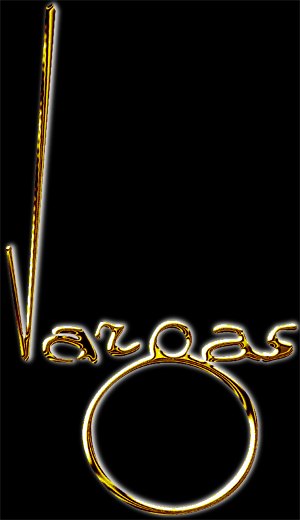 |
Joaquin Alberto Vargas y Chavez was born in Peru in 1896 - two years after George Petty and the same year as Gustaf Tenggren. Like Petty, his father was a successful photographer and both of these classic pin-up artists were exposed at an early age to the airbrush.
This new tool was not the slim, lightweight model that we know today, but rather a large and awkward unit that took considerable skill to use, let alone master. The fine mist of paint that the airbrush sprayed onto a negative or print was worth the effort, however, as it could, in the right hands, emulate the emulsion of a negative or print. This ability to correct flaws in the photographic process (and in the features of the portraiture clients) was a major component to the success of commerical photographers of the era.
In 1911 he went to Paris with his brother and father. The boys were on their way to Switzerland for schooling and eventual apprenticeships, but the Paris stopover changed Alberto's life forever. There he "discovered" his two great artistic idols: Ingres and Raphael Kirchner. Kirchner was a premier artist for La Vie Parisienne and as famous in France as Harrison Fisher and Charles Dana Gibson were in America. Vargas was profoundly influenced by his technique and his approach to the female figure. Below is a Kirchner image from a 1916 portfolio and at right is a Vargas cover for a 1921 American Weekly.
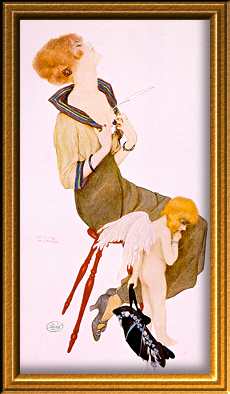
|
 |
| Raphael Kirchner - 1916 | Alberto Vargas - 1921 |
cover in full color in ImageS #1
Vargas was summoned to England in 1916 to begin his apprenticeship with a major English photography house. With World War One swirling around him, he found it impossible to get from Paris to London. It was, however, feasible to get to America and then back to Peru, so he headed for home. He didn't make it.
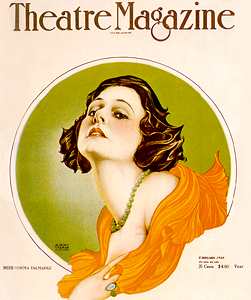 In New York, he began retouching photographs for a living and drawing
and painting. Kirchner and Russell Flint were the men who influenced him the most at
this period, especially Kirchner's paintings for the Ziegfeld
Follies. Kirchner died in 1917 and Florenz Ziegfeld found Vargas
doing a painting exhibition in a window display promotion in 1919.
Vargas became the primary Ziegfeld artist for a dozen years, painting
portraits of all the stars of each season's Broadway extravaganza.
Norma Talmadge from 1920 is at right. Perhaps it was from Ziegfeld
that Vargas developed the tone of his art - the idealized depiction
of the female form glorified but never vulgarized. Sensuality
was everything, but the sex was never blatant.
(Many years later he would find it almost physically impossible
to produce a Playboy image with full frontal nudity
- so ingrained was his respect for his subjects.)
In New York, he began retouching photographs for a living and drawing
and painting. Kirchner and Russell Flint were the men who influenced him the most at
this period, especially Kirchner's paintings for the Ziegfeld
Follies. Kirchner died in 1917 and Florenz Ziegfeld found Vargas
doing a painting exhibition in a window display promotion in 1919.
Vargas became the primary Ziegfeld artist for a dozen years, painting
portraits of all the stars of each season's Broadway extravaganza.
Norma Talmadge from 1920 is at right. Perhaps it was from Ziegfeld
that Vargas developed the tone of his art - the idealized depiction
of the female form glorified but never vulgarized. Sensuality
was everything, but the sex was never blatant.
(Many years later he would find it almost physically impossible
to produce a Playboy image with full frontal nudity
- so ingrained was his respect for his subjects.)
 The
Ziegfeld images could have no bare breasts, yet throughout the
twenties, Vargas created several very exotic nude paintings. It
is probable that these were done to supplement the money that
he was surely earning - and spending with wild abandon. When he
eloped with his wife, Anna Mae, in 1930, he had to borrow the
money to pay for the marriage license. Vargas was never a very
successful business man and when the Follies work ended in 1931,
he scoured the country for income. A sample of his 1933 style
is at left.
The
Ziegfeld images could have no bare breasts, yet throughout the
twenties, Vargas created several very exotic nude paintings. It
is probable that these were done to supplement the money that
he was surely earning - and spending with wild abandon. When he
eloped with his wife, Anna Mae, in 1930, he had to borrow the
money to pay for the marriage license. Vargas was never a very
successful business man and when the Follies work ended in 1931,
he scoured the country for income. A sample of his 1933 style
is at left.
Much of the decade was spent in low-paying positions in the art departments of various Hollywood studios. As the decade drew to a close, Vargas faced desperate times. He was in New York and his wife was still in California. Work was almost non-existent. Then, in an eerie echo of his replacing Kirchner at the Ziegfeld Follies, Esquire hired him to replace George Petty.
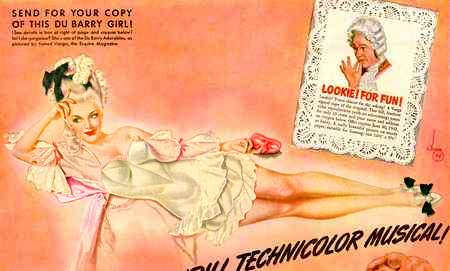
|
| 1943 ad for a Varga movie promotion |
The "Petty Girl" had been a staple of Esquire Magazine since its inception and was generally credited with a good portion of its success. By 1940, Petty's price per picture and other aspects of his relationship with the publisher, David A. Smart, resulted in the magazine scouring the country for a replacement. Vargas was probably the only artist up to the task and Smart responded to his good fortune in finding him by taking every advantage possible of the man. In Vargas, by Alberto Vargas and Reid Austin, the original contract is reprinted in full and is shocking in its lopsidedness.
For instance, Petty was offered $1500 a picture to stay with Esquire in 1941, Vargas was indentured for three years at $75 a week with Esquire as his sole client and Esquire would take 50% of the monies gained from any sale of Vargas artwork. In 1944, under a new contract, Vargas produced almost a painting a week at the princely sum of $1000 a month. And the paintings were simply gorgeous.
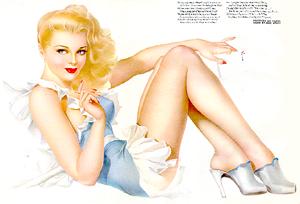 The
gatefold at left is from March 1943 and is very indicative of
why Vargas and Esquire were so popular with G.I.s
in World War Two. Actually, though, it was "Varga" who
was popular. The name had been shortened to make it appear more
exotic. In the ensuing acrimonious lawsuits between Vargas and
Smart, it was revealed that Esquire had patented
the name "Varga" - under which Alberto had developed
his reputation. Of course, the patent was requested and granted
in 1946 immediately after Vargas brought suit against
Esquire to break the contract that bound him exclusively
to the magazine until 1957.
The
gatefold at left is from March 1943 and is very indicative of
why Vargas and Esquire were so popular with G.I.s
in World War Two. Actually, though, it was "Varga" who
was popular. The name had been shortened to make it appear more
exotic. In the ensuing acrimonious lawsuits between Vargas and
Smart, it was revealed that Esquire had patented
the name "Varga" - under which Alberto had developed
his reputation. Of course, the patent was requested and granted
in 1946 immediately after Vargas brought suit against
Esquire to break the contract that bound him exclusively
to the magazine until 1957.
He won the first round, but while the decision was under appeal, he was enjoined from using the "Varga" name. In 1950, the decision was reversed with Esquire owning the name. "Varga" was dead and "Vargas" had to raise himself from the ashes.
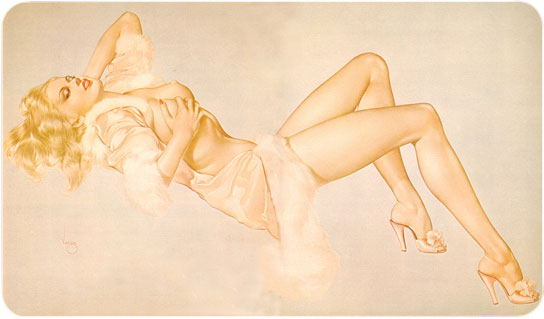
Above is one of the "Legacy Nudes." These and other personal efforts were created during the lean times of the late 40's and 50's and were meant as an "insurance policy" for his wife. Sadly, she died before him.
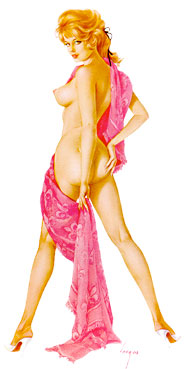 The
early Fifties found Vargas painting some starlet portraits
in True Magazine, playing cards, and other minor efforts. From
1954 to 1957 he had a monthly feature in an obscure British men's
magazine. A pictorial in Playboy in 1957 and trip
home to Peru in 1958 provided much-needed emotional succor, but
the late Fifties were a time of no work. Vargas used the time
to perfect his skills and when, in 1960, Hugh Hefner hired him
to paint foldout nudes for Playboy he was ready.
The
early Fifties found Vargas painting some starlet portraits
in True Magazine, playing cards, and other minor efforts. From
1954 to 1957 he had a monthly feature in an obscure British men's
magazine. A pictorial in Playboy in 1957 and trip
home to Peru in 1958 provided much-needed emotional succor, but
the late Fifties were a time of no work. Vargas used the time
to perfect his skills and when, in 1960, Hugh Hefner hired him
to paint foldout nudes for Playboy he was ready.
At the age of 64, when most people are considering the notion of retirement, Vargas began a new career that would finally give him the respect and financial security he merited. He worked for Playboy for 16 years during which time he produced 152 paintings. Many of them were masterpieces, but the constant need to create a glamourous painting of a sexy 19-year-old month after month often resulted in some formulaic and occasionally perfunctory work.
He retired in 1976. In 1978, with Reid Austin, he wrote Vargas, a compelling tale of his life profusely illustrated with rare and classic and even some previously unseen images. He died in 1982.
 To learn more about Alberto Vargas,
see:
To learn more about Alberto Vargas,
see:|
Illustrations are copyright by their respective owners. This page written, designed & © 2001 by Jim Vadeboncoeur, Jr. Updated 2011. |
